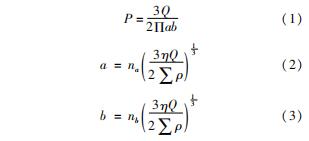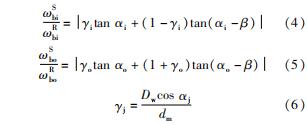基金项目:国家重点项目
作者简介:陶孟尧(1997—),男,硕士,研究领域为液体火箭发动机涡轮泵技术。
1.西安航天动力研究所,陕西 西安710100; 2. 洛阳轴承研究所有限公司,河南 洛阳471039
1. Xi'an Aerospace Propulsion Institute, Xi'an 710100, China; 2. Luoyang Bearing Research Institute Co, Ltd, Luoyang 471039, China
reusability; turbopump; bearing; repeated start-stop operation
DOI: 10.3969/j.issn.1672-9374.2024.01.008
液体运载火箭是人类探索宇宙最重要的工具之一,在建立卫星导航系统、建造空间站、载人登月、火星登陆及其他空间活动中发挥着不可或缺的作用。目前,随着对发射频率、运输成本要求的不断提高,一次性使用液体火箭已无法满足需求,如何降低发射费用成为液体火箭面临的主要难题之一,发展可重复使用液体火箭发动机是解决上述难题的有效途径[1]。
液体火箭发动机具有能量释放强烈、动态发展迅速、工作环境恶劣等特点,设计研制极为困难[2]。涡轮泵作为液体火箭发动机的核心,用于对火箭燃料和氧化剂进行加压,它由许多旋转部件组成,如轴承、密封、叶轮和诱导轮等。涡轮泵工作时,内部处于高转速、高低温、高压及长时间振动的恶劣环境中[3-5],可重复使用需求的提出使得涡轮泵设计难度大大提升,在满足火箭发动机性能的同时,要保证各部件达到预定的工作寿命和重复启停次数。涡轮泵中轴承是轴系支撑和保证泵高速旋转的关键部件,直接关系到发动机的工作可靠性,也是研制可重复使用液体火箭发动机涡轮泵的最重要环节之一。目前几乎全部液体火箭发动机涡轮泵都采用滚动轴承,这种轴承通过点或线形式的机械接触来传递外部载荷,这将导致轴承内出现严重的应力集中现象。对于液氧/煤油发动机涡轮氧泵,轴承会在低温、高DN值(轴承内径×轴承转速)和重载的环境下工作,轴承滚珠与滚道之间的接触应力极高,同时由于液氧的低黏度物性,对轴承润滑效果十分有限,轴承的磨损程度会相当明显,并将随着转速的增加而显著提高,同时磨损产生的热会导致滚珠变黑和变形,甚至会导致保持架和滚珠发生断裂[6-9]。
在涡轮泵启动和停机过程中,轴承润滑环境最为恶劣,Zaretsky等研究了燃气轮机中陶瓷球轴承的应用,发现陶瓷球轴承发热量更低、恶劣润滑环境中工作更稳定[10]。Pasini等对液氧/甲烷液体火箭发动机涡轮泵中应用的轴承进行了试验研究,以验证新形式和新材料的轴承在可重复使用涡轮泵中的应用[11]。Averbach等提出了燃气轮机中轴承的失效模式,研究表明轴承早期剥落是由润滑问题导致的[12]。在轴承寿命研究方面已有很多理论模型,Warhadpande等将轴承疲劳剥落中微裂纹的产生、合并和扩展统一,预测出轴承裂纹扩展阶段的一个重要影响因素为材料塑性[13]。Mitamura等研究了工作温度对轴承接触疲劳寿命的影响,研究发现轴承工作温度升高会大幅缩减轴承寿命[14]。刘耀中等研究了工作工况、材料热处理等因素对滚动接触疲劳寿命的影响[15]。李鸿亮等针对燃气轮机中高温角接触轴承进行了高转速、多次启动的优化设计和试验验证[16]。
目前,国内外对轴承寿命、轴承材料、轴承润滑等方面已有较多研究,但针对液体火箭发动机涡轮泵中特殊工作环境下的轴承设计及试验研究并不全面。涡轮泵可重复使用需求的出现对轴承的设计研制提出了更高的要求,因此本文以我国某型可重复使用液氧/煤油火箭发动机涡轮泵轴承为研究对象,对满足低温、高速、长寿命、多次重复启停等要求的滚动轴承进行设计研制和试验研究。
某型可重复使用液氧/煤油火箭发动机涡轮泵结构如图1所示,主泵整体为三轴四支点支撑方案,涡轮氧泵与煤油泵之间通过弹性轴连接。涡轮氧泵由涡轮、氧泵组成,采用单轴两轴承支撑方案,涡轮端采用角接触球轴承(轴承1),该轴承为双半内圈三点接触结构,具有能承受双向轴向负荷为主的联合负载、高速性能好、工作过程中轴向窜动小的优点,用于承载轴向力,氧泵入口处采用深沟球轴承(轴承2),用于承载径向力,同时也具备一定范围内双向轴向冲击的适应性。煤油泵同样采用单轴两轴承支撑方案,离心轮和诱导轮位于两轴承中间,二级泵叶轮悬臂,二级泵端采用角接触球轴承(轴承3)承载轴向力,煤油泵入口处采用深沟球轴承(轴承4)承载径向力。
针对上述涡轮泵轴承工作环境提出轴承设计要求,如表1所示。
针对涡轮泵中高速重载、重复启停的工况,轴承材料应具有高强度、高硬度及良好的耐磨性和尺寸稳定性。马氏体不锈钢G95Cr18经淬回火、深冷处理后硬度不低于58HRC,同时具有良好的耐磨、耐蚀、耐疲劳性,适用于重复工作、长寿命的需求。
在涡轮泵中,轴承润滑通常采用推进剂自身,但推进剂黏度较低,润滑十分有限,需要依靠保持架材料的转移和流体动压润滑共同完成。保持架材料是维持轴承固体自润滑的主要来源。聚四氟乙烯材料具有摩擦因数小、耐低温等特点,能够满足轴承的长期使用需求。同时,为提高保持架强度,对其采取了加强环增强的措施。
相较在煤油环境中使用的轴承,由于液氧的黏度约10-6~10-7 m2/s量级,流体润滑的效果更差。在运转初期,轴承尚未形成稳定的保持架转移膜,为保证其初始润滑,对液氧环境中轴承1和轴承2的设计采用滚道表面镀银基多层复合润滑膜,以保障涡轮泵启动初期轴承的润滑。
在升、降速的过程中,轴承保持架引导方式和引导间隙直接影响其打滑率,保持架打滑率越小,实际运转速度与理论越接近。在涡轮泵中,轴承内圈随主轴高速旋转,外圈固定。因此,将轴承保持架设计为外圈引导,有助于重复启停中保持架的运转稳定。
以轴承中钢球为对象,建立简化受力模型如图2所示,其中Q为法向接触力,T为拖动力,f为摩擦力,ω为角速度,α为接触角,Mg为惯性陀螺力矩,下标i、o分别代表与钢球接触的内、外圈。
赫兹接触理论是目前工程实际中使用最为广泛的分析方法,对于轴承中的弹性接触变形、应力计算有着足够的精度。该理论将轴承接触应力与接触负荷、材料特性及两个相接触体的几何形状特征建立如下关系[17]。

式中:a、b分别为接触点椭圆的长半轴、短半轴; Q为钢球与滚道的法向负荷; na、nb为接触点主曲率系数; η为两接触物体的综合弹性常数; Σρ为主曲率和函数。
对轴承在30 s内从静止升速到设计转速过程及从满工况降速至静止过程中的最大接触应力变化情况进行计算分析,结果如图3所示。可以看出,在轴承启动过程中,随着钢球离心力的增加,轴承外圈上的接触应力逐渐增大,停机过程与之相反,内圈的最大应力随速度变化较小。4个轴承启停及运转过程中接触应力均小于轴承材料的一般许用应力(3.7 GPa),表明轴承此时仍有一定的安全裕度,可以满足高速运转需求。
轴承的旋滚比是钢球相对滚道的自旋分量与滚动分量之比的简称。钢球相对滚道旋转时,角速度适量可以分解为沿切线方向的滚动分量ωR和沿法向的自旋分量ωS,自旋分量与滚动分量的比值称为旋滚比[17],即

式中:β为钢球的姿态角; Dw为钢球直径; dm为轴承节圆直径。
旋滚比越大,表明自旋滑动摩擦越大,则其引起的发热也越显著。对轴承启停过程中的最大旋滚比变化情况进行计算分析,结果如图4所示。
从图4可以看出,在轴承启动升速过程中,内圈和钢球之间的旋滚比逐渐增大,降速时与之相反,外圈的旋滚比随速度变化较小。当轴承转速达到设计转速时,4个轴承最大旋滚比均小于高速轴承的一般判别准则值(0.4),表明轴承不会因自旋引起过量的发热而产生早期失效。
在轴承高速旋转中,由于陀螺力矩的作用,钢球可能会发生陀螺旋转,使其与滚道发生相对滑动。若要避免这种打滑,就要确保钢球有足够的拖动力来对抗陀螺力矩[17],即

其中
Mg=4.5×10-12D5wnzngsin β (8)
式中; μ为滑动摩擦因数; nz为钢球自转速度; ng为钢球公转速度。
在涡轮泵中,主轴带动轴承内圈转动,内圈是轴承的主动套圈。主动套圈为钢球提供拖动力,以保证其稳定运转,而当拖动力不足时轴承可能发生打滑、异常发热等现象。对需承受轴向载荷的两型角接触球轴承在不同转速下的各个钢球拖动力盈余量进行计算分析,结果如图5所示。可以看出,主动套圈的拖动力随轴承转速升高而减小,当轴承转速达到设计转速时,轴承最小拖动力盈余仍然大于0,表明轴承套圈此时仍对钢球有稳定的拖动,因此在运转过程中均不会产生不稳定现象。
轴承寿命是直接反映轴承能否满足重复长时间使用的重要指标。对于角接角轴承和深沟球轴承,当Dw≤25.4 mm时,轴承基本额定动载荷为
Cr=bmfc(cos α)0.7 Z2/3D1.8w (9)
当Dw>25.4 mm时,有
Cr=3.647bmfc(cos α)0.7Z2/3D1.4w (10)
式中:Dw不吊带承球直径,bm和fc为轴承工艺系数; Z为轴承球数量。α为轴承接触角。
轴承当量动载荷为
Pr=XFr+YFa (11)
式中:X为径向动载荷系数; Y为轴向动载荷系数; Fr为轴承径向载荷; Fa为轴承轴向载荷。
由式(9)~式(11)可得轴承额定寿命为[18]

计算结果如表3所示。可以看出,上述4种轴承的最小寿命为1.9×106 r,满足该型涡轮泵使用需求。
为保证上述轴承在液氧和煤油中安全可靠工作,设计了轴承低温和常温运转试验系统模拟实际工作环境,对轴承性能进行考核测试。
低温运转试验台采用液氮作为试验介质来模拟液氧中低温低黏度的工作环境。试验台由试验器、配气系统、液氮供应和排放系统、涡轮驱动系统等组成,试验台装置如图6所示。其中试验器由轴、壳体、轴承、轴向载荷和径向载荷加载装置组成,采用3个轴承做轴系支撑,结构如图7所示,中间为被试轴承,前端和后端为工艺轴承,冷却采用前腔进液氮串联方式,依次冷却3个轴承。轴向载荷直接施加在前端工艺轴承上,通过轴传递给被试轴承; 径向载荷直接施加在前端工艺轴承外环,根据3个轴承位置关系,通过杠杆作用间接传递给被试轴承。配气系统主要提供空气进行涡轮驱动及通过气压式活塞控制轴承轴向和径向载荷加载。液氮供应方式采用氮气挤压式,保证试验器中液氮压力、流量及温度满足试验技术指标要求,试验后贮箱排放的液氮及加注系统排放的液氮回收到液氮蒸发器内使之转化成氮气排放到高空大气中,以保证试验场区的安全。考虑到低温环境对电机稳定运转的影响,采用空气驱动涡轮的方式拖动试验器,通过调节涡轮入口空气压力来保证涡轮输出转速,可实现无级调速,最高转速可达50 000 r/min,同时利用涡轮的机械特性,在试验器中出现卡涩或其他异常情况时,可自动失速,保证试验系统安全可靠运行。
常温运转试验台采用常温水作为试验介质,由于没有低温对试验台的影响,整体系统结构设计较为简单,与低温运转试验台相比,试验器拖动方式改用电机驱动,可以对试验器转速控制更加精准,运转过程中对功率进行监测,防止试验系统出现异常,试验台装置如图8所示。常温试验器采用四轴承支撑方案,前端为被试轴承,轴向和径向载荷直接加载,试验器结构如图9所示。
采用上述设计的试验系统对4个轴承进行运转试验,涡轮氧泵用轴承1和轴承2进行低温重复起停运转试验,试验前对试验器进行充分预冷确保轴承运转环境温度,然后100 s内将轴承转速从0加速至试验转速,先后加载轴向和径向载荷,轴承满载运转200 s后立即停机并卸去轴向和径向载荷,随后立即启动重复上述试验流程。煤油泵用轴承3和轴承4进行常温重复启停运转试验,试验前无需预冷,试验过程同上。试验过程中对轴承转速、冷却流量、被试轴承壁温、轴承载荷、介质温度、介质压力、涡轮入口压力及电机功率进行监测采集。
图 10为4个轴承试验过程中转速和轴承外壁温的变化情况,轴承1进行了12次重复启停运转,共满载运转2 400 s,其余3个轴承各进行了21次重复启停运转,均满载运转4 200 s。对于轴承1和轴承2低温运转试验,每3次运转后试验台重新补充液氮,所以会出现轴承外壁温回升现象,启动后温度迅速降低,在运转过程中轴承外壁温全程低于-160 ℃,转速基本平稳无异常波动,证明轴承运转状态正常。轴承3和轴承4常温运转试验全程无间断,监测轴承外壁温缓慢爬升,全程低于20 ℃,证明轴承运转状态正常。
试验完成后对轴承进行分解检测分析,轴承状态如图 11~图 14所示,试后4个轴承结构均完好、旋转灵活性良好、钢球和内外套圈基本光亮,钢球表面略有发乌环带和磨损。轴承在受力的情况下连续长时间的运转,钢球对滚道产生机械作用,在内、外圈的滚道表面会留下载荷痕迹。同时,轴承为聚四氟乙烯固体润滑轴承,运转过程中会在保持架、钢球和滚道之间发生转移润滑,因此,在钢球和滚道表面会存在轻微变色,分析认为试后轴承状态属正常现象。
轴承试后检测结果见表4,轴承2径向游隙超出设计值,其他轴承参数均无异常。钢球、滚道表面在微观尺寸下并非完全光滑,在应力的作用下,微凸体会开始发生塑性形变被磨平,而被磨下的微小碎片一方面会填平表面的凹谷部分,另一方面会压在接触表面,起到一定的研磨粒子的作用,使轴承表面慢慢产生一定的磨损,从而引起设计参数也发生一定的变化。对上述重载、润滑环境恶劣及重复启停运转试验后的轴承来说,存在一定的磨损和精度略微超差属正常现象。通过试验过程中对数据的监测及试后轴承外观和尺寸检测结果,认定试后轴承正常,可满足涡轮泵中高转速、重载荷及重复启停的要求。试后同批次轴承搭载可重复使用液氧/煤油火箭发动机试车考核,已成功重复点火十余次,涡轮泵工作正常,试车后轴承转动灵活,分解检查状态良好。
1)针对可重复使用液氧/煤油发动机涡轮泵用4个轴承,本文从材料、结构、保持架等方面开展了轴承设计,对轴承工作状态中接触应力、旋滚比、拖动力及轴承寿命进行了计算分析,理论验证了所设计的轴承满足使用需求。
2)针对上述轴承设计了相应的低温和常温轴承运转试验系统,进行了轴承重复启停运转试验研究,在低温-140~-190 ℃环境中涡轮氧泵止推轴承进行了12次重复启停运转,满载运转2 400 s,涡轮氧泵径向轴承进行了21次重复启停运转,满载运转4 200 s。常温环境中煤油泵止推轴承和径向轴承各进行了21次重复启停运转,均满载运转4 200 s。试验结果表明所设计的4个轴承可以适应涡轮泵中高转速、重载荷和多次重复启停的工作工况,并搭载发动机考核成功。